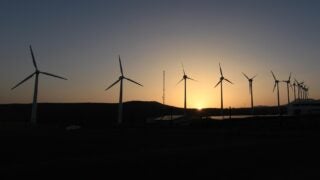Is nuclear power the key to a low-carbon future?
Professor Najmedin Meshkati argues nuclear energy will serve as a cornerstone of the global energy transition.
Najmedin Meshkati is professor of civil and environmental engineering, industrial systems engineering and international relations at the USC Viterbi School of Engineering. The following is an expanded answer to USC News’ question “What role will nuclear energy play in the future?”
The world faces an energy demand explosion of historic proportions. With the global population racing toward 9 billion people, electricity requirements are projected to skyrocket from today’s 9,000 gigawatts to a staggering 15,000 gigawatts by 2050 — a 70% surge that dwarfs all previous energy transitions in human history. This isn’t merely abstract growth. Consider AI infrastructure alone: By 2030, data centers will demand 160% more power than today, consuming electricity equivalent to Canada’s entire national output (approximately 650 terawatt hours annually). This single technological sector will require more power than 38 million American homes combined.
The International Energy Agency confirms this trajectory, projecting that emerging economies will account for 90% of electricity demand growth through 2050, with India’s per-capita electricity consumption set to double within just 15 years. Meanwhile, China already consumes more electricity than the United States, European Union and Japan combined — yet still has substantial growth ahead. These aren’t speculative forecasts but mathematical certainties driven by industrial development, rapid urbanization and technological revolution. Without unprecedented energy innovation, we face a future where demand dramatically outstrips supply, creating economic instability and geopolitical conflict over increasingly scarce resources.
Nuclear energy stands poised to serve as a cornerstone of the global transition to a low-carbon future. Unlike intermittent renewable sources such as wind and solar, nuclear power provides reliable, large-scale baseload electricity that can stabilize energy grids and complement clean energy portfolios. Recent policy and industry developments underscore this renewed momentum.
By 2050, nuclear energy capacity is expected to triple globally to meet net-zero emissions targets, as pledged by 22 countries at COP28 in Dubai in December 2023. Since the initial pledge at COP28, six additional nations have joined the declaration at COP29 in November 2024. The planned restart of the Palisades nuclear power plant in Michigan, which was shut down in 2022, and Unit 1 of the Three Mile Island nuclear power plant, which was not involved in the 1979 accident but was shut down in 2019 due to economic challenges, is expected by mid-2028. Reports indicate that the Duane Arnold nuclear plant in Iowa, which ceased operations in 2020, may also pursue a restart.
This unprecedented trend would mark the first time in U.S. history that decommissioned nuclear plants are brought back online, enabled by federal and bipartisan political support. According to recent reports, due to the unexpectedly slow expansion of renewable energy in Germany, there is a vocal and growing movement to restart some of the country’s 11 shutdown nuclear power reactors.
Emerging nuclear technologies offer promising pathways for overcoming many legacy challenges associated with traditional nuclear energy. Small modular reactors (SMRs) promise to reduce costs, construction timelines and land use while enhancing safety features through passive cooling and underground containment. Additionally, advanced reactor designs — such as molten salt, gas-cooled and thorium-fueled systems — are being developed for greater efficiency and reduced waste generation. These innovations could revolutionize the energy landscape in the coming decades by providing nearly limitless, carbon-free power with minimal safety and waste concerns.
Nuclear fusion, once considered the “holy grail” of energy, has reemerged as a promising energy frontier, with recent breakthroughs bringing practical applications within reach. Unlike fission, fusion offers distinct advantages: minimal radioactive waste, no meltdown risk and fuel derived from abundant resources. The National Ignition Facility’s December 2022 achievement of ignition, producing more energy than consumed, marked a historic turning point. This success has catalyzed investment and innovation. Meanwhile, international projects such as ITER continue advancing plasma control capabilities. Though material engineering challenges persist in handling fusion’s extreme conditions, the field has decidedly shifted from theoretical to technological — potentially delivering a safe, clean and limitless energy source.
To fully realize nuclear energy’s potential, a multipronged policy approach is essential. Governments must invest in financing mechanisms — such as loan guarantees, production tax credits and public-private partnerships — to de-risk nuclear investment. Regulatory frameworks should be modernized to streamline licensing while maintaining rigorous safety standards. Public engagement campaigns must be launched to rebuild trust in nuclear energy through transparent communication and community involvement. Above all, nuclear power must be integrated strategically with renewables in national and international energy plans. If these challenges are met with the urgency and innovation they require, nuclear energy can become not only a viable option but a vital pillar of the clean energy transition.
After four decades of conducting rigorous nuclear safety research and inspections at power plants worldwide — including Three Mile Island, Chernobyl, Fukushima Daiichi and Fukushima Daini, I’ve reached an inescapable conclusion: The global nuclear power industry stands or falls as a single entity. This tightly interconnected chain or interdependent network is fundamentally vulnerable as its weakest link. Today’s resurgence of confidence in nuclear energy — this latest “nuclear renaissance” with its wave of logical expectations and (to paraphrase former Federal Reserve Chairman Alan Greenspan) “rational exuberance” — could collapse instantly under the weight of a single severe accident anywhere in the world. History proves this cyclical pattern: The first renaissance after Three Mile Island was extinguished by Chernobyl, and the second was destroyed by Fukushima. Now, we are witnessing the third “nuclear renaissance” in just 46 years. The stark reality of this industry remains unchanged: “A nuclear accident anywhere is a nuclear accident everywhere.”
The imperative is clear: The global nuclear power industry must urgently intensify international, interdisciplinary collaborative efforts to bolster its safety culture, which is analogous to the human body’s immune system that protects it against pathogens and fends off diseases, with particular focus on its most vulnerable operations. That’s why this industry needs to double down on collaborative efforts, by utilizing engineering diplomacy, to improve its safety culture, especially for its weakest members.



